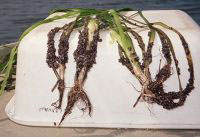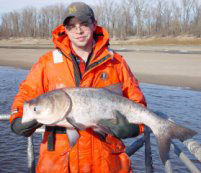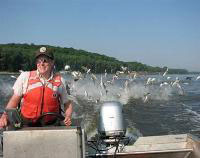Mississippi River Invasive Exotic Species
Many non-native or exotic species have been introduced to Wisconsin from other countries or another part of the U.S., either deliberately or by accident. Some of these plants and animals have not been a detriment to the resource; others have become pests and are considered invasive exotics.
Invasive plants and animals overwhelm native species and can expand their range rapidly because they lack natural competitors and predators to keep them in check. Once established most invaders are difficult if not impossible to control.
Aquatic invasive species have been introduced into the Mississippi River watershed in a number of different ways. Some were introduced deliberately such as carp, whereas others were released accidentally elsewhere and invaded the Mississippi River through watershed connections. The Chicago Sanitary and Ship Canal which connects the Great Lakes to the Mississippi River watershed is one of the main avenues of access to the Mississippi River for aquatic invasive species.
Lake-to-river / river-to-lake connection
Historically the Great Lakes and the Mississippi River basin were separate. More than a century ago channels were built to move freight and people between the Illinois River and Lake Michigan, opening a connection between two of the largest watersheds in the United States. Ultimately the direction of the rivers connected to these canals was changed to carry sewage away from Lake Michigan, which was Chicago’s drinking water source.
The Chicago Sanitary and Ship Canal, has allowed invasive species which have been introduced to the Great Lakes, such as zebra mussels, to move between basins. An electric barrier was activated in April 2002 to prevent fish, primarily round gobies, from moving from one basin to the other.
What you can do to prevent their spread!
Once the invaders are in our waters everyone who boats or fishes has the potential to move them to a new water body.
Natural resource managers are actively monitoring the Mississippi River to better understand where these species are found and what effect they are having. Citizens are also encouraged to aid in monitoring efforts. Learn what these invasive species look like. If you think you have discovered a new infestation of an invasive plant or animal report it to the DNR immediately. In some cases, management decisions are made to protect native populations.
Infamous exotics on the Upper Mississippi River
- Zebra mussels
-
Native to Eastern Europe, zebra mussels were brought to North America as larvae in the ballast water of ships that traveled from fresh-water Eurasian ports to the Great Lakes. They were found in all of the Great Lakes by 1990 and by 1991, the mussels had made their way into Pool 8 of the Mississippi River via the Illinois River. Currents carried the larvae downstream to the confluence of the Mississippi, from which barges could carry them upriver.

Generally, zebra mussels are found growing on solid objects but on the Mississippi River zebra mussels of the year are also found growing in clusters on aquatic plants such as wild celery.These hardy and prolific mollusks can firmly attach themselves to solid objects. The mussels are usually found growing in clusters containing numerous individuals that clog water intakes, encrust piers and docks. Zebra mussels also encrust native mussels ultimately smothering them, which has caused significant declines in native mussels on the Mississippi River.
How far have they spread on the Mississippi River?
As of 2005, their distribution included the entire Wisconsin portion of the Mississippi and extended up to Stillwater in the St Croix River.
Links, reports and publications about zebra mussels in the Upper Mississippi River
- Round gobies
-
These bottom-dwelling fish which can grow to be 10-12 inches long are native to Eastern Europe. First discovered in Lake St. Clair in 1990, presumably introduced via ballast water from transoceanic vessels, the round goby and the tubenose goby have spread to lakes Erie, Michigan and Superior and to the Illinois River. Round gobies are thriving in the Great Lakes basin because they are aggressive, voracious feeders that can forage in total darkness.
How far have they spread?
As of 2007, round goby were considered to infest the Chicago Sanitary and Ship Canal, as well as the lower reaches of the Des Plaines River.
- Rusty crayfish
-
Rusty crayfish are native to the Ohio River drainage and were most likely spread to Wisconsin waters by anglers who dumped their bait buckets. They eat fish eggs and feed on aquatic vegetation, which deprives native fish of food and cover. They also displace native crayfish by forcing the native crayfish from the best daytime hiding places making them more vulnerable to fish predation.
- Asian carp (bighead, silver and grass carp)
-

Bighead and silver carp can potentially disrupt the entire food web in a water body.These carp were first brought to the United States from China in the 1970s by Arkansas fish farmers to improve water quality by removing algae from fish production ponds. They escaped from the fish farms, probably during floods and began to appear in the southern Mississippi River in the 1980s. They have been moving north at a rate of about 50 miles per year and are now present in large numbers below Lock and Dam 19 in Iowa.
Bighead and silver carp are filter feeders, straining tiny animals and plants (plankton) out of the water. Some may eat their weight in plankton daily. In eating plankton, these fish directly compete with native filter feeders such as mussels and fish. This competition for food can potentially disrupt the entire food web in a water body.

Both fish species are known to jump out of the water in response to boat motors!There is great concern about their potential to affect Great Lakes, Mississippi River and St. Croix River fish communities should they become established in Wisconsin waters.
Grass carp were first introduced into southern states in the 1960s to control aquatic vegetation in fish farms. They spread through accidental and illegal, intentional releases. Grass carp have the potential to seriously disrupt the food web, as they can consume considerable amounts of aquatic vegetation that other organisms rely on for food and cover.
Status
Lock and Dam 19 near Keokuk, Iowa has not proven to be an insurmountable barrier to them as a bighead and silver carp were caught in Pool 4 (Lake Pepin) in the fall of 2003 and five Asian carp including two silver, two grass and a bighead carp, were caught by a commercial fisherman in the Mississippi River near La Crosse, December 2008.
Both species are present in the Illinois River and as of 2008 Asian carp appeared to range as far as about 20 miles downstream of the electrical fish barrier or about 50 miles from Lake Michigan.
Controlling Asian carp:
Great Lakes
The only thing that is keeping these fish from moving into Lake Michigan is an electrical barrier system on the Chicago Sanitary and Ship Canal, though this is not a fail-safe system. Although the barrier acts to repel the fish, it doesn’t actually kill them. The construction of similar barriers at two points along the Mississippi has been recommended, though this system will need to be more technologically advanced and thus will be more expensive. This is because the design must allow the free flow of native fish up and downstream for spawning while simultaneously blocking the movement of the Asian carp upstream.
Upper Mississippi River
University of Minnesota researchers are evaluating the possible release of sterile or genetically modified fish, as well as the use of pheromones or other sensory cues, to reduce the numbers of Asian carp in the wild. Early detection of isolated populations may help slow or restrict the spread of these Asian carp. To report a sighting, note the exact location. Freeze specimen in a sealed plastic bag and call your local DNR Service Center
- Faucet snails and exotic parasitic trematodes
-
The faucet snail is a European species that has spread into Wisconsin waters including the Mississippi River. This small snail can serve as an intermediate host for exotic trematodes or flukes, which are intestinal parasites for waterbirds. Trematode caused waterbird mortality was first confirmed on Pool 7 of the Mississippi River near La Crosse, Wisconsin during the 2002 spring migration. Die offs of coots and lesser scaup now occur each spring and fall on Pool 7 and 8. The die-offs of coots and lesser scaup from trematodes closely parallel other locations within Wisconsin where faucet snails have been found.
These species of trematodes have not been reported to infect humans. Further, no human health threats have been documented from handling or consuming waterfowl infected with trematodes.
- Eurasian watermilfoil
-
This aquatic plant is native to Europe and Asia. Its stem fragments cling to boats, motors and trailers and drift with currents to colonize new areas. These fragments can root and grow into new plants, allowing it to spread over long distances. Eurasian watermilfoil may form dense stands, crowding out native vegetation and creating mats so dense that gamefish can’t maneuver through them to snap up their prey. Eurasian watermilfoil is found in portions of the Mississippi River, the St. Croix River south of St. Croix Falls and in more than 380 inland lakes in Wisconsin.
- Curly-leaf pondweed
-
Native to Europe and Asia, this aquatic plant was thought to have been accidentally introduced along with the common carp. It is carried to new water bodies on boats and trailers. Curly leaf pondweed, with its characteristic wavy leaves, grows rapidly early in the spring (even under ice) and shades out native plants. Like Eurasian watermilfoil, it can form dense mats that make it tough to boat or swim. When curly-leaf pondweed dies back in mid-summer it releases nutrients, which can lead to algal blooms and other problems. It is found in portions of the Mississippi and upper St. Croix rivers and their tributaries, as well as an unknown number of inland lakes.
Status on Mississippi River
Currently, neither Eurasian watermilfoil nor curly pondweed has been much of a problem in the Mississippi River. They are both present as a part of the vegetation community but are not dominant. Both can attain very high biomass in limited portions of the river but they seldom maintain that biomass over more than one season.
- Purple loosestrife
-
This plant, introduced from Europe during the 1800s, invades wetlands, lake and river shorelines and moist roadsides where it displaces native vegetation and reduces available habitat and food for wildlife. It spreads by seeds and by broken stems that root in moist soil. Purple loosestrife occupies many shorelines and backwaters along the Mississippi and is still relatively uncommon on the St. Croix, though locally abundant at some lower river sites. It is found in some tributaries of both rivers and in lakes in those systems.
- Common buckthorn
-
This very invasive tree is small, reaching 20-25 feet in height and 10 inches in diameter. Buckthorn is easily spread by birds. It bears small blackberries in late summer, which readily attracts birds such as waxwings and robins. The seeds then pass through their digestive system. After the first tree produces fruit, buckthorn can spread rapidly just from fruit which drops to the ground.
Once established, buckthorn forms a dense thicket that can shade out other plants and shrubs in the understory and may prevent the establishment of other tree seedlings. Unfortunately, it has little wildlife value other than the berries. Despite the fact that its leaves stay green well into winter deer tend to use it only as starvation food.
Buckthorn is widespread in western Wisconsin and can occur anywhere there is a disturbance in the woods. It is also becoming increasingly present in the bottomland forest along the Mississippi River.
Links
- Nonindigenous Aquatic Species [exit DNR], United States Geological Survey (USGS)
- Invasive Carp Overview [exit DNR], Mississippi National River and Recreation Area (U.S. National Park Service)
- Invasive species program [exit DNR] U.S. Fish and Wildlife Service (USFWS)
- Aquatic invasive species (AIS) webpage
- UW Herbarium [exit DNR]
